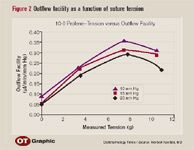Article
Canaloplasty with tensioning sutures results in IOP lowering
London-A reduction in IOP in patients with open-angle glaucoma can be achieved after nonpenetrating glaucoma surgery (canaloplasty) when circumferential suturing is done in the inner wall of Schlemm's canal. This technique results in distension of Schlemm's canal and enhanced outflow of aqueous with the subsequent lowering of the IOP, explained Norbert Koerber, MD, at the XXIV Congress of the European Society of Cataract and Refractive Surgeons in London.

Key to this procedure is the use of an ophthalmic microcatheter (iScience Surgical) that dilates Schlemm's canal. The microcatheter is 200 μm in diameter with a composite multi-element design; it has an atraumatic fiber optic tip for maneuvering in tissue spaces, and it serves as a delivery lumen for tools, materials, and energy, said Dr. Koerber, who operates from the Outpatient Eye Surgery Centre, Cologne, Germany, and at the University Eye Hospital at Padova, Italy.


IOP lowering measured
At 1 month postoperatively, data from 88 patients were available; the average IOP in this group was 16.1 mm Hg with an average of 0.2 medications. At 3 months, 70 patients could be evaluated; again the average IOP was 16.1 mm Hg and the average number of medications was 0.2. Six months postoperatively, 57 patients were evaluated and they had an average IOP of 15.2 mm Hg with an average of 0.4 medications. Nine months after surgery, 14 patients had an average IOP of 14.1 mm Hg with an average of 0.3 medications. And finally, at 12 months, 17 patients also had an average IOP of 14.1 mm Hg with an average of 0.5 medications.
Newsletter
Don’t miss out—get Ophthalmology Times updates on the latest clinical advancements and expert interviews, straight to your inbox.




